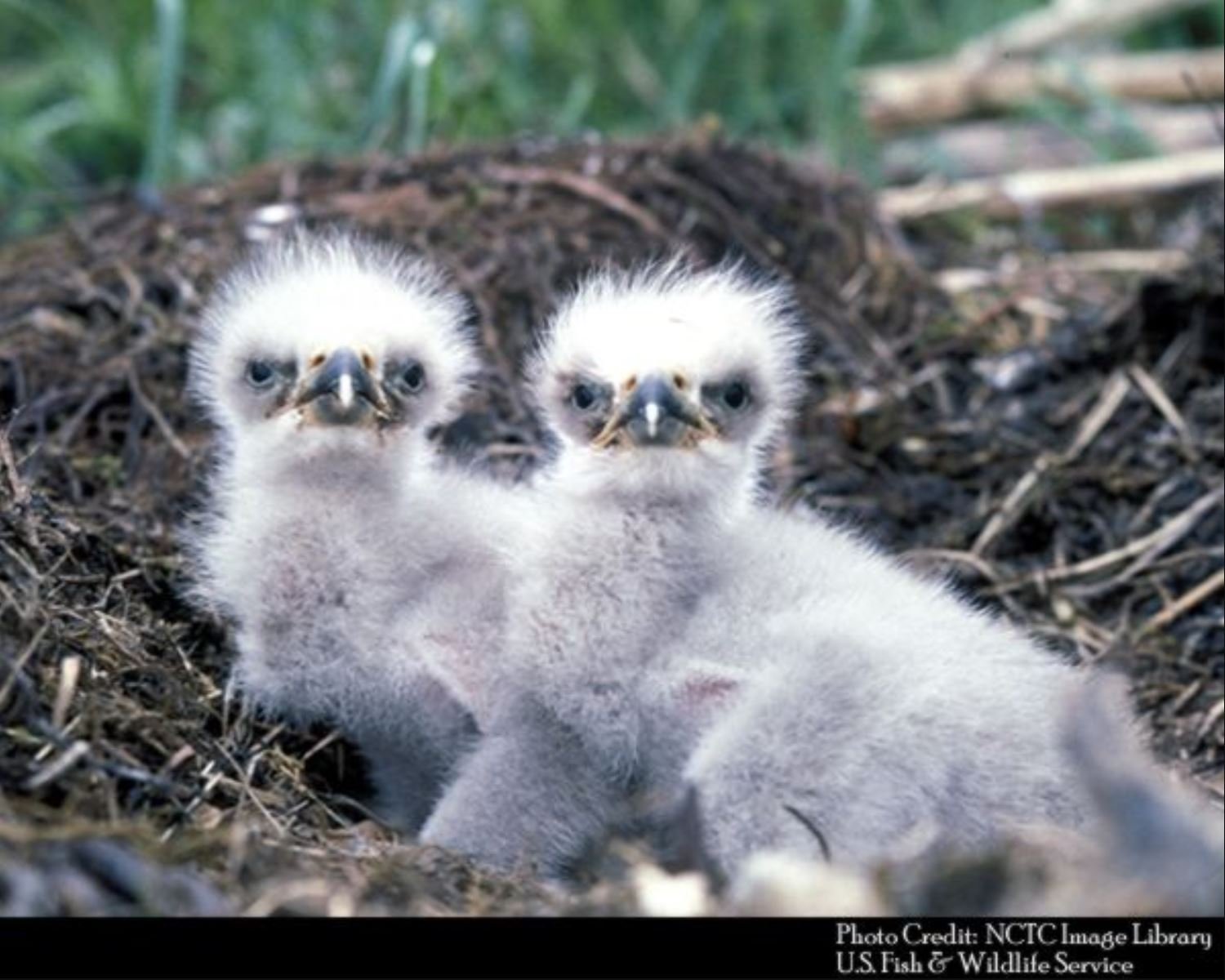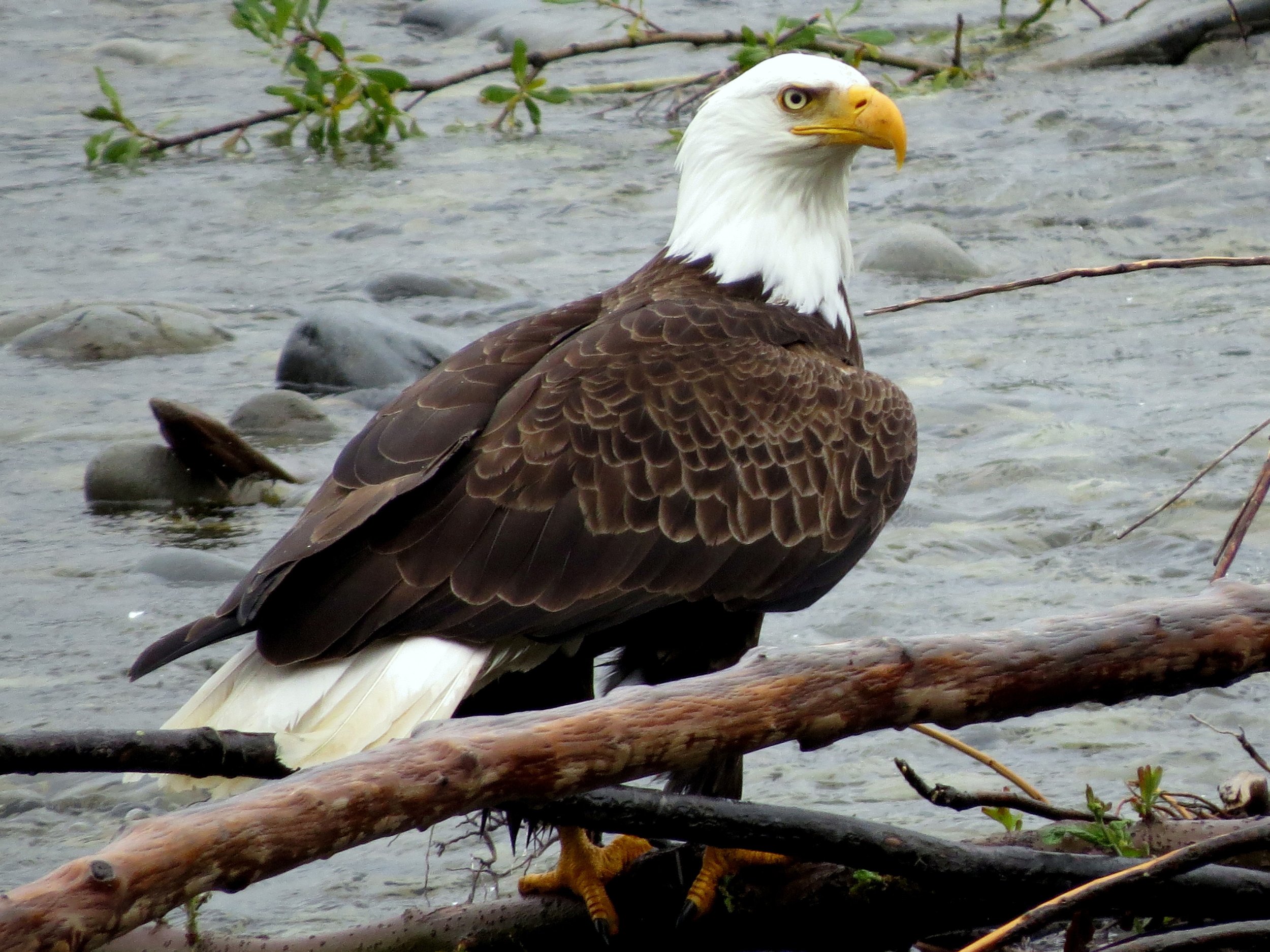Friend Feature: Bald Eagle Haliaeetus leucocephalus
Bald eagle chicks (eaglets) are covered in white, fluffy down for their first 4 weeks before it is replaced with brown. Healthy chicks like these are common now, after a decades-long road to recovery. Image courtesy of the NCTC image library, US Fish & Wildlife Service.
They’re back!
Everyone likes a comeback kid. They’re heroic, they pull at your heart strings, and they remind us to be hopeful in the face of defeat. They come in all shapes and sizes and this one just happens to be (very) pointy at both ends and feathery in between. Meet the comeback kid of the century- the bald eagle.
Eagle hears out Hummingbird’s important message. What do you think she shared? Image by Eric Carr, Salish Sea In Focus
Bald eagles are respected as sacred, strong, courageous beings by Coast Salish peoples. These high-flying relations can travel between this world and the spirit world, bringing messages and prayers to the Creator. It is a good sign to have a bald eagle visit your home, hike, or event. Indigenous peoples are eagle allies and protectors and everyone can join this effort to help keep them a part of our Salish Sea community, their place in which was almost lost forever.
Just a few decades ago it was rare to spot this majestic bird. In fact, environmental mistakes made by newcomers led to their near extinction, followed by environmental repairs which led to their successful recovery. Find out how under “Back from the Brink” below.
Home sweet home
For bald eagles, recovery has been a great success! At this time of year, they are flocking to Salish Sea salt marshes and river banks for a feast! What is on their menu? The finest of wild game: duck and salmon.
Bald eagles love shorelines. This is where they build their nests, perch to rest and observe, and hunt for food. In fact, when scientists surveyed bald eagle nests in Washington State back in 2005, up to 97% of the nests were within 3,000 feet of shoreline (Stinson, et. al., 2007).
You can spy bald eagles along waterways of the Salish Sea by scanning for adults’ bright, white heads against the green trees. Unlike elsewhere in North America, they can be found all year long around the Salish Sea, but in late summer certain ones shift their ranges northwards into coastal British Columbia and Southeast Alaska to enjoy the prolific salmon runs. Come fall they move southward to more salmon spawning rivers and also concentrate in the salt marshes and farm fields of lower mainland BC and Washington where thousands of ducks congregate on their migrations south. Mid-winter, it’s upriver to gorge on salmon, dying by the thousands after spawning in their home streams and lakes.
A young eagle hunts a gull in flight. Image by Joe Gaydos, SeaDoc Society
Adult bald eagle carrying a common murre back to its nest. Image by Joe Gaydos, SeaDoc Society
Hunters and Scavengers
Bald eagles are skilled hunters, and for good reason! Their talons (claws), can be over two inches long. Together with their sharp, curved beaks and powerful, 6 foot wing span they are the perfect arsenal; well-adapted to reach up to 99 mph in a dive and to pierce prey and rip flesh from bone.
Bald eagles will hunt fish, small mammals, and other birds, even great blue herons. If they get their talons embedded in too heavy a fish, they have to paddle to shore using their wings. They sometimes eat amphibians, turtles, and shellfish, too, if they have to.
Though skilled predators, bald eagles are also opportunistic eaters (maybe like you?).
One eagle inverts to steal a morsel of food from another over an oyster bed at low tide. Image by Ken Archer, Salish Sea In Focus
They are not too proud to take an easy (ie. dead) meal nor even to steal food from a friend (see image). They’ve been spotted striking an osprey (death-defying fishers in their own right) to knock a fish from his clutch, then swooping down to snag the falling fish mid-air. If you’re going to be a thief, you may as well make it spectacular! Of course, feasting on festering road kill and moldering salmon isn’t beneath them either, so they are not too choosy. Who can blame them? They can go for days or weeks without feeding, and when they eat, they can gorge.
An adult bald eagle takes great blue herons by surprise. Is she after the birds or stealing the dropped sculpin? Image by Bonnie Block, Salish Sea In Focus
So much rotting salmon, so little time. An adult bald eagle strips intestinges from a spawned-out salmon in a creak bed. Image by Craig Weakley, Salish Sea In Focus
Two birds of a feather
For the first four or five years of their lives, juvenile bald eagles are quite nomadic. Some eagles have travelled as far as California to Alaska, or from Florida to Michigan. Maybe it’s the perfect habitat, or maybe the perfect mate, but these birds eventually settle down, build a nest, and have chicks with a life-long partner. How can you tell them apart? Compare them side by side when they are near their nest or when locking talons in a mid-air, spiraling embrace (see image); the females are 25% larger than the males.
Adults begin nesting in January in the Salish Sea, and not in any modest nest. Mated pairs build enormous nests from large sticks in the top branches of a tall tree and add on every year. Some have been recorded to be over 20 feet tall and 10 feet wide, and some reach over 4,400 pounds, or two tons. They tend, remodel, and update nests with the latest eagle trends year after year. They can become so big and heavy that they cause the tree to fall over, or sometimes the nests simply get knocked down in storms.
Falling in love or fighting for fish? Your guess. Only the photographer knows, but courtship does include locking talons in a spinning free-fall between lovers. Image by Aaron Baggenstos, Salish Sea in Focus
A busy parent and three, 5-6 week old siblings, in their nest high in a Douglas fir tree. Image by Keith Williams, NCTC Image Library, US Fish & Willdife Service
The eagles line the interior of their nests with softer materials like lichens, moss, and downy feathers for a cozy home. Of course, other items are found in nests, too, such as cat and toy-size dog collars. Keep your furry friends leashed up in eagle territory!
Eaglets
Bald eagles typically lay one to three eggs per year that hatch after about 35 days. The eaglets will be tended by a parent at all times for the first two weeks of their lives, and from there the parents will begin to take longer breaks away from the nest. The parents aren’t slacking, though- they’re busy hunting and gathering food to bring back to the nest where they will tear little bits to feed to the eaglets. After about 3-6 weeks, the eaglets will be provided with whole prey that they learn to pick apart. Finally, at about three months old and covered in dark brown feathers, the eaglets begin to practice flying and leave the nest.
It takes 4 years for their beaks to turn yellow and another year after that before their stark white heads contrast with their dark brown body feathers (see image). They will have wingspans up to 6-8 feet across, yet they will only weigh about 10-14 pounds! In the wild, bald eagles can live up to 40 years old, but in captivity they can live much older.
Can you use the key above to tell the age of each of these bald eagles, landing on a mud flat? Image by Dawn Bockus, Salish Sea In Focus
Back from the Brink
As mentioned above, bald eagles came back from near-extinction. EXTINCTION. Meaning, no more left. How could this happen at the hands of a people who made them their national symbol? Like many environmental mistakes, it was a lack of observation, science, and forethought.
In the late 1800’s, settlers began to kill bald eagles because it was believed that they were preying on domestic animals like chickens, lambs, and other livestock. Although untrue (though they do take chickens when they get the chance), the shooting continued. Nesting habitat also began to decline due to trees being taken down for building along waterways, and the two large threats together began the slow decline in the eagle populations.
Bald eagles depend on salmon and you can help keep them thriving by helping protect salmon and their habitat. Image by Joe Gaydos, SeaDoc Society
The need to protect military troops from insect-spread disease during World War II led to the widespread use of a new pesticide, discovered by German chemists. This new pesticide was called dichloro-diphenyl-trichloroethane, or DDT. Soon it was being used on farm crops to kill bugs, too. It was spread on plants on the land and washed into waterways, too. Then the little beings, like grasshoppers, mice, and fish that ate the plants became toxic to predators in their food chain; predators like bald eagles and other raptors (birds of prey). The DDT prevented production of egg shells thick enough to withstand parents laying on them to keep them warm. Fragile eggs= scrambled eggs and no eaglets, nor hawk, falcon, owl, kestrel, or osprey chicks.
Luckily, in 1962 a brave and thoughtful woman named Rachel Carson wrote a book called Silent Spring that showed how pesticides were harming wildlife. Thanks to her, DDT was banned in the US in 1972 and Canada soon followed suit. Raptors have been recovering here ever since. They have recovered so well that in 2007 bald eagles were removed from the Endangered Species List.
Bald eagles aren’t out of the woods quite yet and yes, you can help. How?
Now that you know that eagles love salmon and ducks, so anything you do to improve their habitat, like planting native plants along waterways or even in your own yards, avoiding the use of pesticides and chemical fertilizers in your lawn, and using wildlife-friendly cleaning supplies around your home helps keep water pure for the whole food chain.
If you are a hunter or know one, make sure you don’t use lead shot in your gun. Lead is toxic to people and nonhuman beings. Sometimes animals that have been shot are not found by hunters. Eagles can ingest that lead when they feast on the carrion. Lead can cause very harmful effects on people and non-human beings, including brain damage and death.
If you can, speak up for wildlife! Participate in habitat restoration, and share your knowledge with others in order for folks to know that we should try not to repeat our past mistakes. Go watch some birds and try to find eagles yourself! Once you see them in all of their majesty, you may just realize how much you want to continue to protect them.
Adult bald eagle soaring high, giving us courage when we need it to do the same. Image by Neil Aldridge, Salish Sea In Focus














